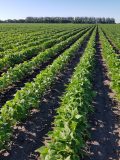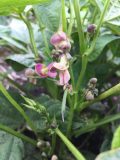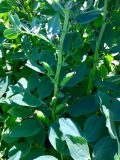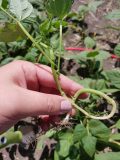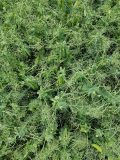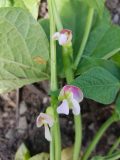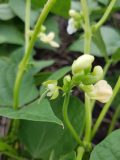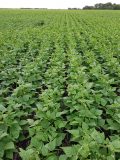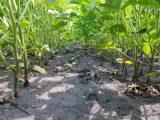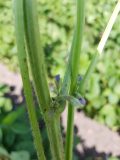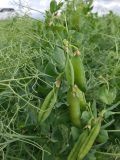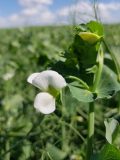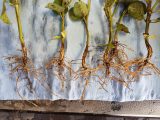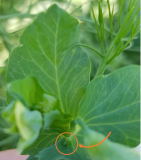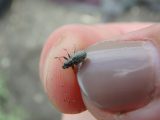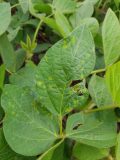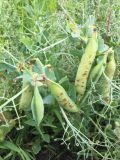July 22, 2020
- Crop Update
- Foliar Fungicide and Diseases in Soybeans
- Managing White Mould in Dry Beans Using Fungicide
- Assessing Grasshopper Damage
- Late Infection of Phytophthora Root Rot
- Scouting for Soybean Cyst Nematode
Listen to The Bean Report:
Crop Update
- Soybeans are mainly at full bloom with the first pods forming on the lower nodes (R2 to R3).
- There have been no reports of soybean aphids or spider mites yet in MB. Grasshoppers, thistle caterpillars and green cloverworm are popping up here and there.
- Bacterial blight has been common this year, with infection setting in following environmental damage.
- Dry beans range from beginning bloom (R1) to beginning pod with early pin beans (R2).
- Fungicide applications to prevent white mould are in full swing. Weather conditions in much of the province have been conducive for disease development this year.
- Field peas range from full flower/flat pod (R3) to beginning maturity (R5), with most at full pod (R4).
- Once field peas have reached R4, fungicide application is no longer recommended. At this late stage, peas are within the 30-day pre-harvest interval of several products and disease should no longer be yield-limiting.
- Faba beans are at flat pod (R4).
Pest Findings
Foliar Fungicide and Diseases in Soybeans
 Each year, soybean and pulse crops are surveyed for diseases across Manitoba. We commonly find septoria brown spot, bacterial blight, downy mildew and frogeye leaf spot in soybeans in MB. However, these infections are rarely severe enough to be yield-limiting. White mould infection generally occurs less frequently, but it can have a greater impact on yield if present.
Each year, soybean and pulse crops are surveyed for diseases across Manitoba. We commonly find septoria brown spot, bacterial blight, downy mildew and frogeye leaf spot in soybeans in MB. However, these infections are rarely severe enough to be yield-limiting. White mould infection generally occurs less frequently, but it can have a greater impact on yield if present.
MPSG’s On-Farm Network has been evaluating foliar fungicide use in soybeans since 2014, comparing treated vs. untreated soybeans. Fifty-nine trials have been conducted to-date. So far, we have seen eight positive yield responses out of 59. This means soybeans benefited from a foliar fungicide application only 14% of the time.
The Soybean and Pulse Agronomy Lab at the University of Manitoba led by Kristen MacMillan has also been evaluating soybean fungicide products and application timing from 2017 to 2019. So far, there has been no yield response to foliar fungicide treatment in soybeans. Dry conditions in the last three years likely contributed to low disease pressure, as all foliar fungal leaf disease severity ratings were low (<1.6/5).
Fungicide application is expected to protect yield only when fungal disease pressure is severe enough to be yield-limiting. And here in Manitoba, soybean yields are not often limited by septoria brown spot or white mould.

Managing White Mould in Dry Beans Using Fungicides

Use the Fungicide Decision Worksheet for Managing White Mould in Dry Beans to determine your field’s infection risk. The first application should be at the R2 (pin bean) stage when all plants have an open blossom or the first pin pods are 0.5 to 1 inch long. The second application should be 7-14 days later, if conditions continue to promote disease development.
Efficacy experiments evaluating difference fungicide products have been conducted in Manitoba, North Dakota and Alberta:
- Boscalid (group 7/Lance WDG, Cotegra) – Consistently provided excellent control of white mould in dry beans in MB, ND and AB.
- Prothioconazole and fluopyram (groups 3 and 7/Propulse) – Showed good to excellent control in ND and AB at full rates. Lower rates did not consistently provide satisfactory control.
- Fluazinam (group 29/Allegro 500F) – Performed best when excellent coverage could be obtained, as it is a contact fungicide. This product also performed best on upright beans.
- Picoxystrobin (group 11/Acapela) – Resulted in poor to moderate white mould control in MB and ND.
Assessing Grasshopper Damage

There have been some reports of grasshoppers in soybean crops. Follow these tips for assessing grasshopper damage:
- Populations are typically concentrated along field edges, so a border spray may be all that is needed. As other crops are harvested or as ditches are mowed, we often see grasshoppers move into soybeans.
- Refer to defoliation levels and action thresholds to determine if insecticidal control is needed. Low levels of defoliation will not cause economical yield loss.
- Action thresholds:
- Dry beans – 15% defoliation after bloom
- Soybeans – 15% defoliation from bloom to pod-fill; 25% defoliation from pod fill to maturity (unless pod feeding is observed)

Late Infection of Phytophthora Root Rot

Phytophthora root rot (PRR) is a root and stem disease specific to soybeans. Unlike other root rot pathogens, PRR can infect soybeans at any development stage.
Late infection of PRR appears as wilted leaves remain attached to the plant and a chocolate-brown lesion that extends upward from the soil line. Dig up roots to confirm – if roots are rotten, it is likely PRR. If a stem lesion is present and roots appear healthy, it may be another stem disease like northern stem canker or pod/stem blight.
PRR produces zoospores that travel with water. In a wetter year such as this, we may see more late-season infection of PRR than usual. Keep an eye out for this disease from now until R7.
Visit the link above for more information on PRR, including the latest survey and research results.
Soybean Cyst Nematode
- Scout for SCN from late July through September by digging up roots and visually examining them for cysts. Soak the roots in water to help identify any cysts that may be present.

SCN cyst vs. root nodule. Source: Wisconsin Soybean Marketing Board - Cysts will be white, lemon-shaped and much smaller than root nodules.
- As SCN was only identified in MB in 2019 at very low levels of infection, we do not expect to see above-ground symptoms. Focus your scouting efforts in field approaches, low spots or any generally low-yielding areas of the field.
- Note: Above-ground symptoms only appear under severe levels of infection and may resemble other crop conditions (e.g., effects of salinity or nutrient deficiency).
- Knowledge is power. The sooner you identify the presence of SCN in your field (if any), the sooner you can start managing it to protect your yields.
If you think you have found SCN in your field, collect samples and contact Cassandra or Laura.
On-Farm Network Update

Nodule counts, disease ratings and general trial scouting have been keeping the On-Farm Network team busy over the past couple of weeks! Nodule ratings in a dry bean nitrogen trial are showing a trend of declining nodulation with increasing nitrogen fertilizer rates (see picture). A similar trend, although less pronounced, was also observed in our pea nitrogen fertility trial.
With most of our fungicide trials established, disease ratings are underway to determine the efficacy of fungicide applications in peas, soybeans, dry beans and faba beans. Keep an eye on social media for updates!


